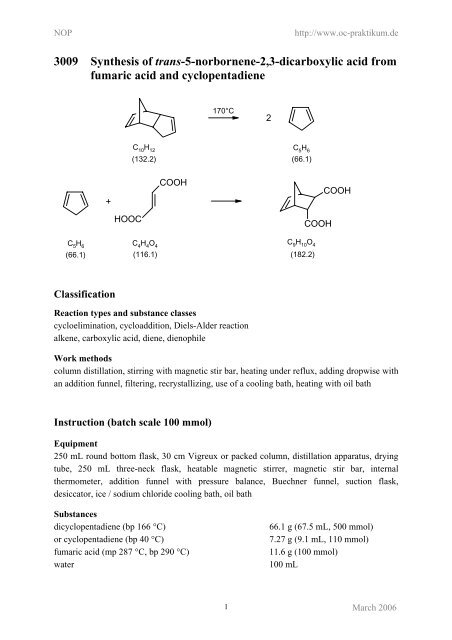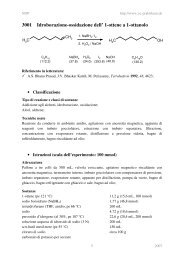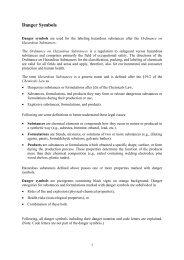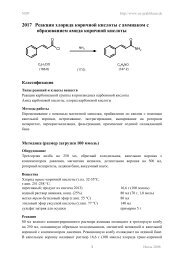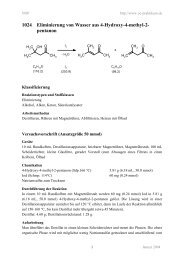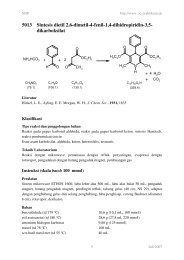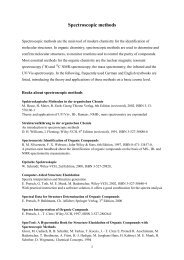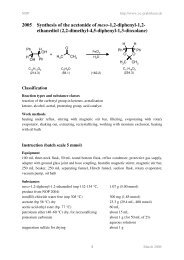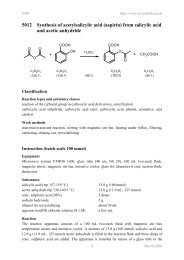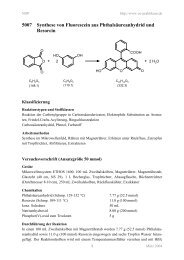3009 Synthesis of trans-5-norbornene-2,3-dicarboxylic ... - kriemhild
3009 Synthesis of trans-5-norbornene-2,3-dicarboxylic ... - kriemhild
3009 Synthesis of trans-5-norbornene-2,3-dicarboxylic ... - kriemhild
You also want an ePaper? Increase the reach of your titles
YUMPU automatically turns print PDFs into web optimized ePapers that Google loves.
NOP http://www.oc-praktikum.de<br />
<strong>3009</strong> <strong>Synthesis</strong> <strong>of</strong> <strong>trans</strong>-5-<strong>norbornene</strong>-2,3-<strong>dicarboxylic</strong> acid from<br />
fumaric acid and cyclopentadiene<br />
C 5 H 6<br />
(66.1)<br />
+<br />
Classification<br />
HOOC<br />
COOH<br />
170°C<br />
C10H12 C5H6 (132.2) (66.1)<br />
C 4 H 4 O 4<br />
(116.1)<br />
Reaction types and substance classes<br />
cycloelimination, cycloaddition, Diels-Alder reaction<br />
alkene, carboxylic acid, diene, dienophile<br />
1<br />
2<br />
C9H10O4 (182.2)<br />
COOH<br />
COOH<br />
Work methods<br />
column distillation, stirring with magnetic stir bar, heating under reflux, adding dropwise with<br />
an addition funnel, filtering, recrystallizing, use <strong>of</strong> a cooling bath, heating with oil bath<br />
Instruction (batch scale 100 mmol)<br />
Equipment<br />
250 mL round bottom flask, 30 cm Vigreux or packed column, distillation apparatus, drying<br />
tube, 250 mL three-neck flask, heatable magnetic stirrer, magnetic stir bar, internal<br />
thermometer, addition funnel with pressure balance, Buechner funnel, suction flask,<br />
desiccator, ice / sodium chloride cooling bath, oil bath<br />
Substances<br />
dicyclopentadiene (bp 166 °C) 66.1 g (67.5 mL, 500 mmol)<br />
or cyclopentadiene (bp 40 °C) 7.27 g (9.1 mL, 110 mmol)<br />
fumaric acid (mp 287 °C, bp 290 °C) 11.6 g (100 mmol)<br />
water 100 mL<br />
March 2006
NOP http://www.oc-praktikum.de<br />
Reaction<br />
Preparation <strong>of</strong> cyclopentadiene:<br />
The reaction apparatus consists <strong>of</strong> a 250 mL round-bottom flask equipped with a 30 cm<br />
Vigreux or packed column with a distillation bridge. The distillation bridge is connected with<br />
a drying tube, the receiving flask is cooled in an ice / sodium chloride cooling bath. No<br />
smaller distillation flask should be used, because strong foaming can occur during the<br />
reaction.<br />
66.1 g (67.5 mL, 500 mmol) dicyclopentadiene is slowly heated in the reaction flask under<br />
stirring until it is strongly boiling at an oil bath temperature <strong>of</strong> 170-200 °C. After a short time<br />
the monomer cyclopentadiene starts to distill over. The oil bath temperature is adjusted, so<br />
that the distillation temperature does not exceed 45 °C. The reaction is finished, when under<br />
these conditions no more distillate passes over. The cyclopentadiene should be used<br />
immediately, since it dimerises again at room temperature. If necessary, it can be stored in the<br />
freezer over night.<br />
Cycloaddition:<br />
11.6 g (100 mmol) fumaric acid and 100 mL water are filled in a 250 mL three-neck flask<br />
with magnetic stir bar, addition funnel, reflux condenser and internal thermometer. Under<br />
stirring 7.27 g (9.1 mL, 110 mmol) cyclopentadiene are added dropwise with an addition<br />
funnel. Afterwards the mixture is carefully heated to an internal temperature <strong>of</strong> about 70 °C<br />
under reflux. When the main part <strong>of</strong> the cyclopentadiene has reacted, what means that the<br />
upper phase has disappeared, the mixture is heated for one further hour until the reflux<br />
temperature <strong>of</strong> the water is reached. Then the reaction solution is cooled down to 0 °C.<br />
Work up<br />
The precipitated product is sucked <strong>of</strong>f, washed with a small amount <strong>of</strong> ice-cold water and<br />
dried in the desiccator over silica gel under reduced pressure.<br />
Yield: 16.2 g (88.9 mmol, 89%), colourless crystals, mp 88 °C. With TLC and NMR no<br />
impurities can be detected.<br />
The product can be recrystallized from water.<br />
Waste management<br />
Waste disposal<br />
Waste Disposal<br />
distillation residue organic solvents, halogen free<br />
filtrate solvent water mixtures, halogen free<br />
Time<br />
3-4 hours<br />
Break<br />
Before sucking <strong>of</strong>f the product<br />
Degree <strong>of</strong> difficulty<br />
Medium<br />
2<br />
March 2006
NOP http://www.oc-praktikum.de<br />
Instruction (batch scale 10 mmol)<br />
Equipment<br />
50 mL round-bottom flask, 30 cm Vigreux or packed column, distillation apparatus, drying<br />
tube, 25 mL two-neck flask, heatable magnetic stirrer, magnetic stir bar, internal thermometer,<br />
graduated pipette, Buechner funnel, suction flask, desiccator, ice / sodium chloride cooling<br />
bath, oil bath<br />
Substances<br />
dicyclopentadiene (bp 166 °C) 6.61 g (6.8 mL, 50 mmol)<br />
or cyclopentadiene (bp 40 °C) 727 mg (0.91 mL, 11.0 mmol)<br />
fumaric acid (mp 287 °C, bp 290 °C) 1.16 g (10.0 mmol)<br />
water 10 mL<br />
Reaction<br />
Preparation <strong>of</strong> cyclopentadiene:<br />
The reaction apparatus consists <strong>of</strong> a 50 mL round-bottom flask equipped with a 30 cm<br />
Vigreux or packed column with a distillation bridge. The distillation bridge is connected with<br />
a drying tube, the receiving flask is cooled in an ice / sodium chloride cooling bath. No<br />
smaller distillation flask should be used, because strong foaming can occur during the<br />
reaction.<br />
6.61 g (6.85 mL, 50 mmol) dicyclopentadiene is slowly heated in the reaction flask under<br />
stirring until it is strongly boiling at an oil bath temperature <strong>of</strong> 170-200 °C. After a short time<br />
the monomer cyclopentadiene starts to distill over. The oil bath temperature is adjusted, so<br />
that the distillation temperature does not exceed 45 °C. The reaction is finished, when under<br />
these conditions no more distillate passes over. The cyclopentadiene should be used<br />
immediately, since it dimerises again at room temperature. If necessary, it can be stored in the<br />
freezer over night.<br />
Cycloaddition:<br />
1.16 g (10.0 mmol) fumaric acid and 10 mL water are filled in a 25 mL three-neck flask with<br />
magnetic stir bar, addition funnel, reflux condenser and internal thermometer. Under stirring<br />
727 mg (0.91 mL, 11.0 mmol) cyclopentadiene are added with a graduated pipette.<br />
Afterwards the mixture is carefully heated to an internal temperature <strong>of</strong> about 70 °C under<br />
reflux. When the main part <strong>of</strong> the cyclopentadiene has reacted, what means that the upper<br />
phase has disappeared, the mixture is heated for one further hour until the reflux temperature<br />
<strong>of</strong> the water is reached. Then the reaction solution is cooled down to 0 °C.<br />
Work up<br />
The precipitated product is sucked <strong>of</strong>f, washed with little ice-cold water and dried in the<br />
desiccator over silica gel under reduced pressure.<br />
Yield: 1.50 g (8.20 mmol, 82%), colourless crystals, mp 88 °C. With TLC and NMR no<br />
impurities can be detected.<br />
The product can be recrystallized from water.<br />
3<br />
March 2006
NOP http://www.oc-praktikum.de<br />
Waste management<br />
Waste disposal<br />
Waste Disposal<br />
distillation residue organic solvents, halogen free<br />
filtrate solvent water mixtures, halogen free<br />
Time<br />
3-4 hours<br />
Break<br />
Before sucking <strong>of</strong>f the product<br />
Difficulty<br />
Medium<br />
Analytics<br />
TLC<br />
TLC-conditions:<br />
adsorbant: Merck silica gel 60 F254, 5 x 10 cm<br />
eluent: ethanol<br />
visualizing reagent: iodine-vapor in the iodine chamber<br />
Rf (product) 0.69<br />
fumaric acid product<br />
4<br />
March 2006
NOP http://www.oc-praktikum.de<br />
1 H NMR spectrum <strong>of</strong> the pure product (250 MHz, acetone-D6)<br />
11 11<br />
10<br />
9<br />
8<br />
7<br />
6<br />
δ (ppm) Multiplicity Number <strong>of</strong> H Assignment<br />
1.41 Ddd, 2 J = 8.5, 3 J = 4.0, J = 1.8 1 CH2<br />
1.61 m, 2 J = 8.5 1 CH2<br />
2.62 dd, 3 J = 4.6, J = 1.8 1 CH-COOH<br />
3.12 M 1 CH<br />
3.24 M 1 CH<br />
3.35 dd, 3 J = 4.6; 3 J = 4.1 1 CH-COOH<br />
6.09 dd, 3 J = 5.8, J = 2.7 1 CH=CH<br />
6.29 dd, 3 J = 5.8, J = 3.0 1 CH=CH<br />
9 Bs 2 COOH<br />
2.09 solvent<br />
5<br />
4<br />
5<br />
3<br />
2<br />
1<br />
0<br />
March 2006
NOP http://www.oc-praktikum.de<br />
13 C NMR spectrum <strong>of</strong> the pure product (62.5 MHz, acetone-D6)<br />
200<br />
175<br />
150<br />
δ (ppm) Assignment<br />
47.2 CH2<br />
48.6 CH<br />
48.9 CH<br />
49.3 CH-COOH<br />
49.4 CH-COOH<br />
136.8 CH=CH<br />
139.2 CH=CH<br />
175.7 COOH<br />
176.9 COOH<br />
30.6, 206.6 solvent<br />
125<br />
100<br />
75<br />
6<br />
50<br />
25<br />
0<br />
March 2006
NOP http://www.oc-praktikum.de<br />
IR spectrum <strong>of</strong> the pure product (KBr)<br />
Transmission [%]<br />
70<br />
60<br />
50<br />
40<br />
30<br />
20<br />
10<br />
0<br />
4000 3500 3000 2500 2000 1500 1000 500<br />
Wellenzahl [cm -1 ]<br />
(cm -1 ) Assignment<br />
2300-3300 O-H-valence, carboxylic acid<br />
C-H-valence, superimposed by O-H<br />
1725 C=O-valence, carboxylic acid<br />
7<br />
March 2006


